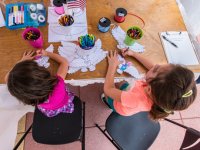Supporting ELLs in PBL Projects
PBL is valuable for ELLs when it teaches academic vocabulary, encourages collaboration, scaffolds structure and function, allows assessment and differentiation, and leverages their native language.
We all have English-language learning students that we must support in our classrooms, and we can support these students through project-based learning. PBL projects can give students something to latch onto as they're learning to use a new language. This can be more engaging than studying words and skills in an abstract way, as the language is being used for an authentic purpose. PBL projects should be used for giving language relevance and context. This does, however, have implications for project design. We need to make sure that our projects have specific pieces to support ELL students.
Analyze the Project
We know the PBL project design process is quite lengthy, and we get better at it the more we do it. Even veteran PBL project designers may not have considered the steps of analyzing the project through the lens of ELL:
- What skills will students need in terms of the language?
- What vocabulary instruction might they need?
- What sort of speaking and listening skills should we scaffold?
- What functions of the language must be considered?
These are the types of questions that teachers need to think about -- and plan for accordingly -- before launching the project.
Teach Academic Vocabulary
Although the driving question and even the project launch may not be full of academic language, academic language will appear in a project. This might be specialized vocabulary whose meanings change depending on the context, or it might be technical words that represent only one concept. Knowing these words ahead of time can help you plan instruction for teaching them to students inside the project. While all students will need this scaffolding, ELL students may require more targeted instruction.
Collaborative Group Work
It is critical that teachers demand collaborative learning within a project. This can be done through critique and revision, as well as collaborative products that students produce. There may also be smaller collaborative activities like labs and team builders. Why collaborative group work? It allows ELL students to be supported by their peers. It gives them opportunities to orally use and practice the academic vocabulary and other language structures and functions. Yes, you will need to build the culture for collaboration, but the payoff is that students are building their language skills more and more within the project.
Scaffold Structure and Function
Through your analysis of the PBL project, you will uncover specific functions and structures of the language that students will need in order to succeed in the project. For example, if you were doing a science project around genetics and traits, you might find that students will need to "justify" the answers in their final product. Or perhaps they'll be required to use the "If _______, then _______" structure. You'll need to give students these tools for showing what they know about the content. Provide sentence starters and stems, and make sure to create lessons that scaffold how to justify. Set these as specific assessment targets as well.
Assess and Differentiate
As mentioned earlier, it is important to assess not only the content, but also the language. As you scaffold and teach vocabulary, structure, and function of the language, make sure to assess these skills, too. Through assessment, you'll be able to see what further scaffolds and instruction you should be providing. Again, I'm saying only assess, not grade. Through assessment of these students' language skills, you can decide how you will differentiate, whether through products or process.
Leverage the Native Language
How amazing is it that many of our students can speak multiple languages? In your project, ask how you can leverage that asset. Can they create a product in both languages? Many of our PBL projects are authentic and reach real audiences to make real impact in the world around us. Instead of demanding only products in English, ask for products in both English and another language to broaden the project's audience and impact. In addition, students could interact with audience members that you never would have imagined, whether this happens throughout the project or during the final presentation. Instead of seeing language as a barrier to the project, view it as an opportunity.
In many ways, all of our students are ELLs, and we need to think intentionally about how to support each one in learning the language. PBL projects can provide a relevant and real context to do this. However, through supporting ELL students, we need to treat all languages as assets, not deficiencies. Through this lens, we can develop literacy in all languages, not just English.
